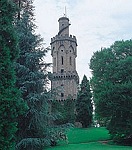| Comune: | Firenze |
| Via: | de' Serragli, 146 |

The Torrigiani Garden, one of the few large green areas to survive perfectly intact inside the city walls, is a typical example of the Romantic style garden in vogue in the early 19th century. A piece of Torrigiani property known as the Campuccio is known to have existed as early as the 16th century. At the end of the 18th century the family line died out and cardinal Luigi Torrigiani's inheritance passed into the hands of the great-nephew Pietro Guadagni, who took the name of his great-uncle and began work on the creation of a garden in the small Campuccio property. Between 1802 and 1817, the new marquis Torrigiani purchased more land to extend the property, which ran from Via del Campuccio as far as Via dei Serragli, and to the walls, where Piazza Tasso now stands: as a result of these acquisitions the holding spread over 10 hectares. The commission to design the layout of the grand garden went to Luigi Cambray Digny, who was later succeeded by the young Gaetano Baccani. The presence of walls served to give movement to the design, which featured so many small buildings, statues and botanical varieties that soon after its creation a 'visitor's handbook' was needed. This guide mentioned over thirty points of interest, including the Hypogeum, Merlin's Cave, the Covered Carousel, the Citrus and Flower Garden, the Riding School, the Arcadia, the Hermitage, the Gymnasium, the Great Tower, The Bird Trap, the Lemon House and the River, with its magnificent bridge. Today's garden, though not quite as full of attractions as in earlier centuries, has survived intact and remains Florence's most important English-style garden. The present-day entrance on Via del Campuccio leads to a generous space marked by a large circular flower bed divided into four parts with, at its centre, a classical statue group by Pio Fedi of Seneca with the young Pietro Torrigiani. A path winds its way up the hill past the Gymnasium and Hermitage (on the right) to the highest point of the garden near the ancient city walls, built by Cosimo the Elder, where Baccani's famous tower stands. This tower, built in 1824, was designed as an astronomical observatory, and also included a library, a collection of astronomical instruments and an open terrace for star-gazing. Other notable sculptures present in the garden include a Baroque work by Baratta, a marble statue group known as the "Greek sculpture" of a bull being killed by a lion, a statue of Osiris next to the entrance on Via de' Serragli (with the explanatory panels on the behaviour expected of visitors to the garden), a marble column dedicated to the great botanist Pier Antonio Micheli, who worked extensively in this area in the early 18th century, and statues of Janus and Aesculapius. The history of this garden is important just as much for its botanical as for its architectural interest, as is clear from the many hothouses (old and new), lemon houses, tepidaria and an extensive collection of plants and trees. In 1839 Attilio Pucci drew up an inventory of the botanical holdings, naming 5,500 potted plants (including pineapple, rhododendrons, camellias and citrus trees) and over 13,000 bedded trees and plants, including various fruit trees, magnolias, pines and cypresses.

